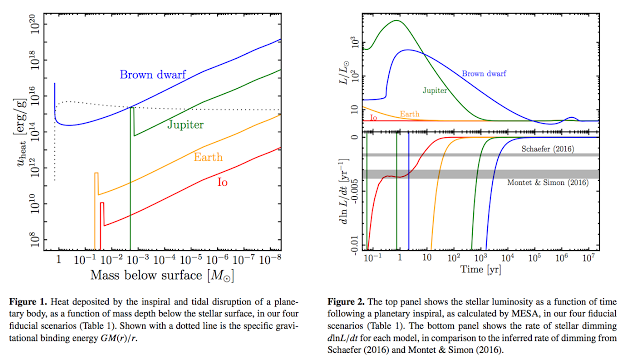Arxiv – Secular Dimming of KIC 8462852 Following its Consumption of a Planet
The Kepler-field star KIC 8462852, an otherwise apparently ordinary F3 main-sequence star, showed several highly unusual dimming events of variable depth and duration. Adding to the mystery was the discovery that KIC 8462852 faded by 14% from 1890 to 1989, as well as by another 3% over the 4 year Kepler mission.
Over the 4 year period of the nominal Kepler mission (Borucki et al. 2010), the star underwent several dimming events of variable depth and duration, ranging from approximately 0.5 − 20% reduction in the total stellar flux. These events are often asymmetric in shape, displaying an apparent lack of periodicity and repeatability. Groups of clustered dips were observed, centered around days 800 and 1500 (‘D800’ and ‘D1500’, respectively), but smaller dips are detected at other
phases over the observing period. Various hypotheses have been put forward to explain the peculiar behavior of KIC 8462852
Following an initial suggestion by Wright and Sigurdsson, researchers propose that the secular dimming behavior is the result of the inspiral of a planetary body or bodies into KIC 8462852, which took place ~10 to 10,000 years ago (depending on the planet mass). Gravitational energy released as the body inspirals into the outer layers of the star caused a temporary and unobserved brightening, from which the stellar flux is now returning to the quiescent state. The transient dimming events could then be due to obscuration by planetary debris from an earlier partial disruption of the same inspiraling bodies, or due to evaporation and out-gassing from a tidally detached moon system. Alternatively, the dimming events could arise from a large number of bodies comet- or planetesimal-mass bodies placed onto high eccentricity orbits by the same mechanism (e.g. Lidov-Kozai oscillations due to the outer M-dwarf companion) responsible for driving the more massive planets into KIC 8462852. The required high occurrence rate of KIC 8462852-like systems which have undergone recent major planet inspiral event(s) is the greatest challenge to the model, placing large lower limits on the mass of planetary systems surrounding F stars and/or requiring an unlikely probability to catch KIC 8462852 in its current state.
The observed dimming behavior of KIC 8462852 can be explained as the slow decline in luminosity on timescales of
∼ 10 to 10 thousand years, depending on the mass of the consumed planet. Perhaps the biggest current challenge to our model is the high required occurrence rate of planet-star impact events, given the detection of even a single such dimming event in the Kepler sample. Reducing the statistical improbability of observing a KIC 8462852-like system to a reasonable value requires both a high total mass of planets in F star systems on radial scales r ∼ 1 − 100 AU, and an efficient mechanism for driving them into the central star over a timescale comparable to the stellar lifetime. For the latter, we have invoked the eccentric Lidov-Kozai mechanism (§2), which indeed could be efficient at draining the planetary system into KIC 8462852 if the apparent M-dwarf companion of KIC 8462852 is indeed gravitationally bound to it.
The strength of their model is that it provides a plausible causal connection between secular dimming and the short-timescale dipping behavior, which to their knowledge is absent from other proposed explanations.

Brian Wang is a Futurist Thought Leader and a popular Science blogger with 1 million readers per month. His blog Nextbigfuture.com is ranked #1 Science News Blog. It covers many disruptive technology and trends including Space, Robotics, Artificial Intelligence, Medicine, Anti-aging Biotechnology, and Nanotechnology.
Known for identifying cutting edge technologies, he is currently a Co-Founder of a startup and fundraiser for high potential early-stage companies. He is the Head of Research for Allocations for deep technology investments and an Angel Investor at Space Angels.
A frequent speaker at corporations, he has been a TEDx speaker, a Singularity University speaker and guest at numerous interviews for radio and podcasts. He is open to public speaking and advising engagements.


